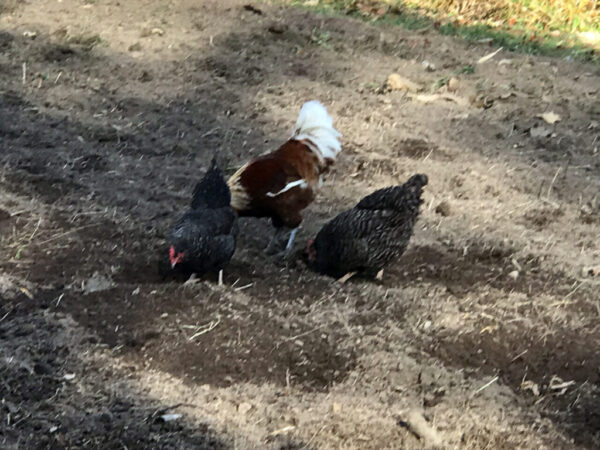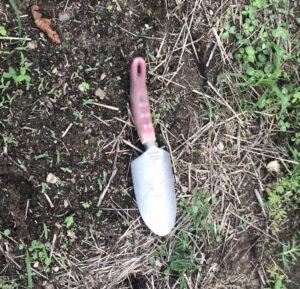- Like
- Digg
- Del
- Tumblr
- VKontakte
- Buffer
- Love This
- Odnoklassniki
- Meneame
- Blogger
- Amazon
- Yahoo Mail
- Gmail
- AOL
- Newsvine
- HackerNews
- Evernote
- MySpace
- Mail.ru
- Viadeo
- Line
- Comments
- Yummly
- SMS
- Viber
- Telegram
- Subscribe
- Skype
- Facebook Messenger
- Kakao
- LiveJournal
- Yammer
- Edgar
- Fintel
- Mix
- Instapaper
- Copy Link

A version of this column first ran in the Roane County (WV) Reporter and Times Record. Support local journalism! Subscribe to your local newspaper. This is one of a series of blogs for new gardeners. Start reading the whole series here: Part 1.
A guest column by my neighbor, Master Gardener Robin Wilson
Honoring, building and protecting our soil brings us healthy vegetables, lessens floods and droughts and protects against erosion. Our best teachers in soil care are our woodlands. The fall leaves mulch and protect even the steepest ground from running off in a violent thunderstorm.
Reaching under the leaves for a handful of woods soil, one sees the dark colored, carbon-rich humus and spongey, crumbly texture created by fungus and bacteria breaking down the leaves from previous years. These leaves contain carbon captured in the magical alchemy of mixing carbon dioxide from air with water, sunlight and some soil nutrients to produce high-energy sugars and cellulose in photosynthesis.
When I was a child, soil was viewed as merely a prop to hold up plants nourished by the NPK—nitrogen, phosphate and potassium—chemical fertilizer that the gardener/farmer added to the soil.
Going back to trees as teachers, the huge oak tree does not show the light green leaves of nitrogen deficiency because nature’s soil-web-of-life recycles the nitrogen, plus all the other nutrients our plants need.
The first stars in this web of life are the helpful microscopic bacteria and fungi. One teaspoon of soil can contain a billion bacteria and several yards of fungus filaments—sometimes visible as white threads. Earthworms have these helpful decomposing bacteria and fungus in their guts, as do we humans.
Moving up the food, chain bacteria and fungi are also food for the still microscopic protozoan life like amoebas. Leaf cutting ants are farmers too—they get fungus to decompose leaves into food while bacteria keep them healthy with antibiotics. Our garden plants are more resistant to disease, drought and root-eating nematodes with these mutually beneficial fungal webs called mycorrhiza (a fancy Latin and Greek way of saying fungus root). This web of small fungus hype can reach out ten times as far as the plant roots to get water and nutrients like soil phosphates. These soil fungi also produce a sticky substance known as globulin which builds good soil structure. In return the plant provides exudates, life-giving sugars, to the fungus.
The soil web needs the carbon from dead plants, but how about the often limiting N—nitrogen for our gardens? Our atmosphere is 78% nitrogen but it is unavailable to plants without the help of bacteria. One can see these helpful bacteria as small nodules on the roots of legumes like peas and beans. These nitrogen fixing bacteria are also free living in the soil. When chemical fertilizer is present, the plant doesn’t spend the energy taking the free nitrogen from the air.
I find that mulching my garden in the spring feeds the soil web, suppresses weeds and conserves moisture. In the fall I like to plant rye and vetch as a cover crop on top of what’s left of the mulch. This can be done with a garden rake used like a hoe to get the seeds under the remaining mulch.
By late spring the cover crop can provide more than four feet of growth above ground. One rye seed can produce a mile of roots below ground while the vetch likes to use its tendrils to crawl up the rye and fix the nitrogen underground.
My soil test shows I do not need to add further nutrients to my soil. Helping build healthy soil is a way of giving back for the many blessings nature gives us.
Read the rest: Part 1. Part 2. Part 3. Part 4. Part 5. Part 6. Part 7. Part 8. Part 9. Part 10. Part 11. Part 12. Part 13. Part 14. Part 15. Part 16. Part 17. Part 18. Part 19. Part 20. Part 21. Part 22. Part 23. Part 24. Part 25. Part 26. Part 27. Part 28. Part 29. Part 30.













